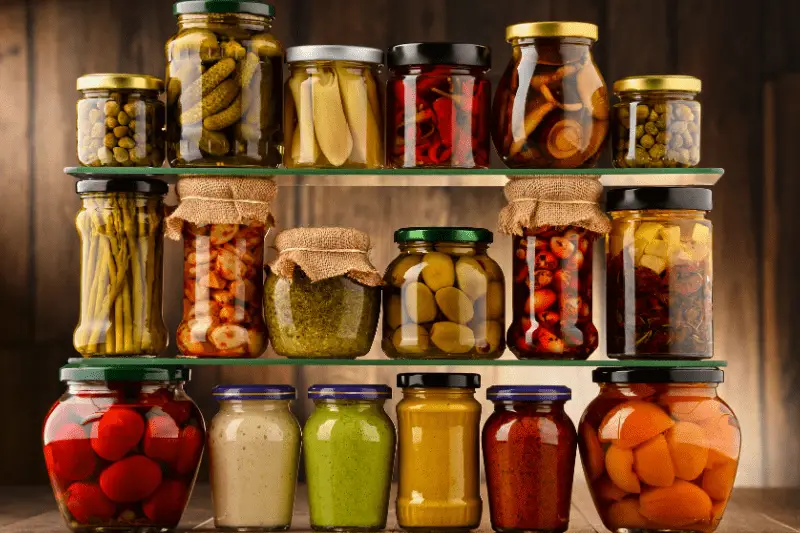Pickling has been around for centuries, and it’s a great way to preserve food while also adding delicious flavor.
Pickling is a fun and easy process that can be done at home with just a few simple ingredients. If you’re interested in starting to pickle at home but don’t know where to start, this article is for you.
In this article, we will cover everything you need to know to get started with pickling at home, from the equipment you’ll need to the different types of pickles you can make.

What is Pickling?
Pickling is a process of preserving food in a solution of salt, vinegar, and sometimes sugar and spices.
The pickling solution creates an environment that prevents the growth of bacteria, allowing the food to be preserved for a longer period of time.
Pickling can be done with a wide variety of foods, including vegetables, fruits, and even meat.
Benefits of Pickling at Home
There are many benefits to pickling at home, including:
- Preserving seasonal produce: Pickling is a great way to preserve seasonal produce so that you can enjoy it all year round.
- Controlling the ingredients: When you pickle at home, you have control over the ingredients you use. You can avoid preservatives and artificial colors and flavors.
- Saving money: Buying pickled products at the store can be expensive, but pickling at home can save you money in the long run.
- Creating unique flavors: Pickling allows you to experiment with different flavor combinations, creating unique and delicious pickles.
Types of Pickles
There are two main types of pickles: fermented pickles and vinegar pickles.
Fermented pickles are made by placing vegetables in a saltwater brine, allowing them to ferment naturally over time.
Vinegar pickles are made by boiling vinegar, water, sugar, and spices together and pouring the mixture over the vegetables.
Here are some common types of pickles:
- Dill pickles: These are made with cucumbers and flavored with dill and garlic.
- Bread and butter pickles: These are made with cucumbers and flavored with sugar and spices.
- Pickled beets: These are made with beets and flavored with cinnamon and cloves.
- Pickled onions: These are made with onions and flavored with vinegar and sugar.
- Kimchi: This is a Korean-style pickle made with cabbage and spices.
Equipment Needed for Pickling
Here are the essential equipment needed for pickling at home:
- Jars: Glass jars with lids are ideal for pickling.
- Canning equipment: You will need a canning pot, jar lifter, and canning funnel for canning your pickles.
- Cutting board: You’ll need a cutting board to chop your vegetables.
- Knife: A sharp knife is essential for cutting your vegetables.
- Large pot: You’ll need a large pot for boiling your pickling solution.
Ingredients for Pickling
The ingredients you’ll need will depend on the type of pickle you’re making, but here are some common ingredients:
- Vegetables: Cucumbers, carrots, beets, onions, and cabbage are all popular pickling vegetables.
- Salt: Salt is used to create a brine solution for fermented pickles
- Vinegar: Vinegar is used for making vinegar pickles.
- Sugar: Sugar is used to balance out the acidity in the vinegar and add sweetness.
- Spices: Spices such as dill, garlic, cinnamon, and cloves are commonly used to flavor pickles.
Basic Steps for Pickling
The basic steps for pickling are as follows:
- Prepare your vegetables: Wash and chop your vegetables as desired.
- Prepare your pickling solution: For vinegar pickles, boil your vinegar, water, sugar, and spices together. For fermented pickles, mix salt and water to create a brine solution.
- Pack your jars: Pack your vegetables into your jars and pour the pickling solution over them.
- Process your jars: If canning, process your jars in a canning pot according to the recipe instructions. If not canning, simply refrigerate your pickles.
Safety Tips for Pickling
When pickling at home, it’s important to follow proper safety procedures to avoid foodborne illness.
Here are some tips:
- Use clean, sterile equipment: Make sure your jars and utensils are clean and sterile before using them.
- Use proper ratios: Make sure to use the correct ratios of salt, vinegar, and other ingredients.
- Store your pickles correctly: Store your pickles in the refrigerator or process them in a canning pot to ensure they’re properly preserved.
- Discard any spoiled pickles: If you notice any signs of spoilage, such as mold or an off smell, discard the pickles immediately.
Troubleshooting Common Pickling Problems
Here are some common pickling problems and how to troubleshoot them:
- Soft pickles: This can happen if you use overripe vegetables or if your pickling solution isn’t acidic enough. To prevent soft pickles, use firm vegetables and make sure your pickling solution is properly balanced.
- Cloudy brine: A cloudy brine can be caused by excess bacteria growth. To prevent this, make sure your equipment is properly sterilized and follow the recipe instructions carefully.
- Hollow pickles: This can happen if you don’t pack your jars tightly enough. Make sure to pack your jars tightly with vegetables to prevent hollow pickles.
Pickling Recipes to Try
Here are some delicious pickling recipes to try:
- Classic Dill Pickles
- Sweet Bread and Butter Pickles
- Spicy Pickled Carrots
- Pickled Red Onions
- Fermented Sauerkraut
Tips for Storing and Serving Pickles
Here are some tips for storing and serving your pickles:
- Store your pickles in the refrigerator for up to several months.
- Serve your pickles as a side dish or snack.
- Use your pickles as a topping for sandwiches, burgers, and salads.
- Chop up your pickles and use them in potato salad or coleslaw.
Final Thoughts
Pickling is a fun and easy way to preserve food while also adding delicious flavor.
With just a few simple ingredients and some basic equipment, you can start pickling at home today.
Whether you prefer fermented or vinegar pickles, there’s a recipe out there for you to try.
Remember to follow proper safety procedures to avoid foodborne illness and troubleshoot any common pickling problems that may arise.
FAQs
- How long does it take to pickle vegetables?
- The time it takes to pickle vegetables depends on the recipe and the method you’re using. Some pickles can be made in a few hours, while others take several days.
- Do I need to use canning equipment for pickling?
- No, you don’t necessarily need to use canning equipment for pickling. You can simply refrigerate your pickles
- Can I reuse pickle brine?
- Yes, you can reuse pickle brine to make a second batch of pickles or to add flavor to other dishes.
- Can I pickle fruits as well as vegetables?
- Yes, you can pickle fruits as well as vegetables. Fruits such as apples, pears, and peaches can be pickled in a sweet brine.
- Can I adjust the level of spice in my pickles?
- Yes, you can adjust the level of spice in your pickles by adding more or less of the spices called for in the recipe. You can also experiment with different spices to create unique flavor combinations.
